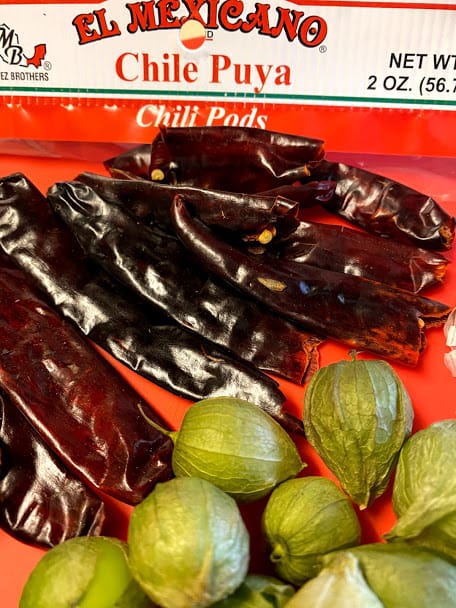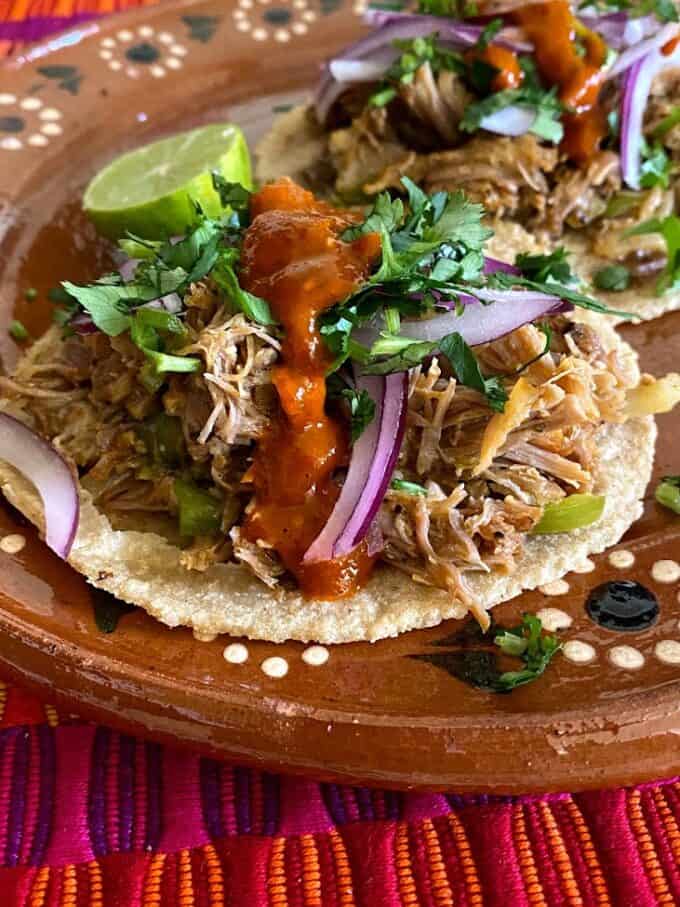This salsa prepared with chile puya and tomatillos is currently my favorite salsa! It has a nice bite, but it is not overly spicy. I like spicy though, so it may be spicy for your taste. You can add less chile puya or mix in some chile guajillo to yield a more mild salsa. Big thank you to my friends Santiago and Patty for sharing this delicious salsa combination with me! Have you had a chance to browse through my first cookbook Mexican Salsa?

Write It Down!
How many times have you wished you would have written down a recipe that you created and didn’t? I learned years ago to write everything down! I have a library of notebooks filled with hand written recipes. I definitely see a cookbook in my near future!

How will you prepare your ingredients?
There are different options when it comes to preparing salsa. You can simply boil the ingredients gently until softened. Dry roast on the stove top griddle or fry the ingredients in a little oil. The results will be slightly different flavors. All delicious and just slightly different. If you toast the dried chiles until they blacken in spots, you’ll taste a nutty, toasted, even smoky flavor in your salsa. The color of the salsa may be darker as well. I toasted the chile puya a little longer in the pic above and you can see the tiny specs of black in the salsa. Same with the Roasted Salsa Verde. It’s really up to you in the end how you enjoy your salsa.

So Many Chiles, So Little Time!
I discovered chile puya a few years back and instantly loved it! I literally have been developing salsa recipes for over 25 years. I love testing new combinations. It’s never ending! I have to hold back sometimes, because my refrigerator can only hold so many jars, lol! Search the web for different varieties of dried chiles like puya, costeno and morita. Chiles should be on the soft side and not brittle.

For Dipping Or For Tacos?
Some salsa recipes I like to reserve for tacos. This is one of them. Of course you can enjoy it with chips, but you better triple the recipe! I tend to prepare my salsas spicy! I don’t suggest those for dipping your chips in. It just a little touch to finish garnishing your favorite tacos.

It’s a Sticky Situation!
Pick tomatillos that have a loose husk and are dark green in color when purchasing them. If the husk is really stuck on there, just peel them under lukewarm water and the husk comes away easily.

Dry Toasting or Frying?
If you feel comfortable frying the chiles, then I would fry! It’s faster and adds a different flavor. Dry toasting is tasty too, just make sure you have good ventilation, lol! We have all been there! Coughing!!! Oh My! See notes at the end of recipe for more info on frying and toasting dried chiles. If you have a power blender, you won’t need to soak your chiles in hot water. Otherwise, I would suggest soaking the toasted chiles for 10 minutes in very hot water.

More Salsa Recipes?
You can have a salsa making night one day and then taco night the next day!

Why Do You Cook Your Salsa???
The number one question that I get is why do I cook my salsa after I blend it? Pectin! Did you know that tomatoes and tomatillos contain a natural pectin in them? Pectin is what is used to prepare jelly. By cooking the blended salsa for 8-10 minutes, the pectin cooks out. The results are a smoother, better tasting salsa that last a few days longer when refrigerated. In the video below it was not cooked after blending. It was still warm, so it flows nice. Once refrigerated, it will thicken slightly.
It’s Not Set In Stone!
You don’t have to cook it, but it does improve the salsa. If you know that the salsa will be eaten in one to two days, then skip cooking it. In my case, I store the salsa, refrigerated, for 10 days, or more and use it as needed. I confess that I did cook the salsa after I shot these photos, lol!


Chile Puya Tomatillo Salsa
Ingredients
- 1 lb. tomatillos peel husk and rinse off tomatillos
- 1 tbsp. avocado
- 12-14 chile puya remove stems
- 2-4 large cloves of garlic
- Handful of fresh cilantro
- Salt to taste
Instructions
- Place the peeled and washed tomatillos in 4 cups of water in a medium pot. Bring to a boil.
- Reduce the heat and continue cooking for 7-9 minutes or just until tomatillos begin to turn from bright green to opaque green. Remove from heat.
- In a separate skillet, heat oil to medium heat. Remove the stems from the chile puya and transfer to skillet with oil. Toss the chiles often so they don't burn. They should be aromatic and change slightly in color. Some chiles will become bright red, others may appear darker. Use tongs to transfer to the blender jar. In that same oil, add the cloves of garlic and saute for 3-4 minutes. Transfer to the blender with chiles.
- To the chiles in blender, pour 1 cup of the cooking water from the reserved tomatillos. Blend chiles first, on high, until very smooth. You may need to scrape down the sides or add a little more water so it blends smooth. Drain most of the water from remaining tomatillos and transfer to the blender with chile sauce. Add washed cilantro and salt to taste. Again, blend on high until very smooth. Taste for salt. Pour into serving bowl.
- Now, if you want a smoother, better tasting salsa that will last a few days longer, do this! Transfer the blended salsa to a pot and heat to medium. When it comes up to a boil, reduce the heat, Continue cooking the salsa for 8-10 minutes. Pour hot salsa in glass jars with tight lids. Let cool and then refrigerate to store. You will lose the fresh cilantro flavor once salsa is cooked though. You could serve it either way. Salsa will last 10 days or more refrigerated.
Notes

Please explain how you fry chiles.
I am sorry Candace, I thought I explained that in my instructions for the salsa. I don’t prefer to heat up the oil too much ahead of time because the chiles might burn fast. I don’t want that because it can make the salsa bitter. You want to use a neutral oil like avocado, grapeseed or canola oil. I will revise the instructions so it’s more clear.
Hi Sonia, thank you for all your wonderful recipes, you have a great blog!! How long will the cooked salsas usually last refrigerated, jus curious, I know store bought last a long time but not sure about homemade, thanks again!!!
The store bought last a long time because they have preservatives and vinegar in them. Homemade salsa with no vinegar last only a few days to one week if kept refrigerated. If I make a large jar of salsa I add a couple of tablespoons of vinegar and add it after I blend it when I am cooking. I cook them for about 10 minutes. I learned this a few years back. The cooking cooks out the natural pectin that is found in tomatoes and tomatillos. This process yields a smoother, better tasting salsa that last a few days longer than usual.
Hola! Made the coditos with carne! Minus the Serrano and Poblano pepper, didn’t have any, used a jalapeño instead! Turned out fantastic! A big hit the family!🌶😍
I am so happy your family enjoyed the recipe Susi! Thank you for taking the time to comment!
My respects, but I have to mention that prior to reading your article and recipe I had already experimented with making different salsas using traditional recipes and authentic ingredients. My first attempt at a tomatillo salsa was preceded by extensive research. One of the main topics of debate and discussion was preparation methods for yielding the best results. I found that it is highly advised not to use the water that the tomatillos were cooked in if you want to avoid bitterness in the salsa. Would you care to weigh in?
Hi Patrick,
I have been preparing salsa for at least 35 years, no lie. I honestly have rarely experienced a bitter salsa form using the cooking water from tomatillos. I will tell you that I do use only fresh water or broth when it comes to softening dried and chiles. Some people use the cooking water, but I prefer not to chance it. The bigger the tomatillo, in my experience, the more sour it has been. I have been surrounded by traditional mexican home cooks my whole life have seen the cooking water from tomatillos used often. I always try to let people make those decisions for themselves. If they feel ok with using the cooking water, then I suggest that. When in doubt, taste the water before adding it. I find myself telling my followers all the time that tomatillos are naturally sour. Without the right amount of seasoning, the salsa will be sour.I find myself preparing both red and green tomatillo based salsas a lot lately and have used the cooking water in everyone of them.I learned a few years back that I am only to cook the tomatillos until they change color and that I should avoid letting them pop open as they simmer. I was told that would make the salsa bitter. I find there are so many different opinions and we all have to find what works best for us.
What would the ratio of puya to de arbol be? We have a friend who owns a local Mexican restaurant who uses these chiles for their house tomatillo salsa. We can’t get enough! Your recipe is the closest we’ve come to making it at home based off his instructions.
Hi Keisha, sorry for the late response. I was away from my PC until now. Chile de arbol is more spicy so, I probably would only add 1/3 of the peppers. I couldn’t give you an exact count because all brands may vary in size. In my experience, some brands of chile de arbol are really spicy. Plus because you are not using as much chiles, the salsa will not come out as red.